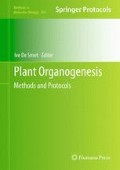Abstract
Cell-based computational modeling and simulation are becoming invaluable tools in analyzing plant development. In a cell-based simulation model, the inputs are behaviors and dynamics of individual cells and the rules describe responses to signals from adjacent cells. The outputs are the growing tissues, shapes and cell-differentiation patterns that emerge from the local, chemical and biomechanical cell-cell interactions. Here, we present a step-by-step, practical tutorial for building cell-based simulations of plant development with VirtualLeaf, a freely available, open-source software framework for modeling plant development. We show how to build a model of a growing tissue, a reaction-diffusion system on a growing domain, and an auxin transport model. The aim of VirtualLeaf is to make computational modeling better accessible to experimental plant biologists with relatively little computational background.
Access this chapter
Tax calculation will be finalised at checkout
Purchases are for personal use only
References
Dupuy L, Mackenzie J, Rudge T, Haseloff J (2008) A system for modelling cell–cell interactions during plant morphogenesis. Ann Bot-London 101:1255–1265
Grieneisen VA, Scheres B (2009) Back to the future: evolution of computational models in plant morphogenesis. Curr Opin Plant Biol 12:606–614
Chickarmane V, Roeder AH, Tarr PT et al (2010) Computational morphodynamics: a modeling framework to understand plant growth. Annu Rev Plant Biol 61:65–87
Santos F, Teale W, Fleck C et al (2010) Modelling polar auxin transport in developmental patterning. Plant Biol 12(Suppl 1):3–14
Keurentjes JJ, Angenent GC, Dicke M et al (2011) Redefining plant systems biology: from cell to ecosystem. Trends Plant Sci 16:183–190
Kitano H (2002) Systems biology: a brief overview. Science 295:1662–1664
Merks RMH, Guravage M, Inzé D, Beemster GTS (2011) VirtualLeaf: An open-source framework for cell-based modeling of plant tissue growth and development. Plant Physiol 155:656–666
Merks RMH, Glazier JA (2005) A cell-centered approach to developmental biology. Physica A 352:113–130
Anderson ARA, Chaplain MAJ, Rejniak KA (eds.) (2007) Single-cell-based models in biology and medicine. Birkhaüser, Basel
Meinhardt H (1976) Morphogenesis of lines and nets. Differentiation 6:117–123
Benítez M, Espinosa-Soto C, Padilla-Longoria P, Díaz J, Alvarez-Buylla ER (2007) Equivalent genetic regulatory networks in different contexts recover contrasting spatial cell patterns that resemble those in Arabidopsis root and leaf epidermis: a dynamic model. Int J Dev Biol 51:139–155
Bouyer D, Geier F, Kragler F, Schnittger A, Pesch M, Wester K, Balkunde R, Timmer J, Fleck C, Hülskamp M (2008) Two-dimensional patterning by a trapping/depletion mechanism: the role of TTG1 and GL3 in Arabidopsis trichome formation. PLoS Biol 6:1166–1177
Merks RMH, Van de Peer Y, Inzé D, Beemster GTS (2007) Canalization without flux sensors: a traveling-wave hypothesis. Trends Plant Sci 12:384–390
Jönsson H, Heisler MG, Shapiro BE, Meyerowitz EM, Mjolsness E (2006) An auxin-driven polarized transport model for phyllotaxis. P Natl Acad Sci USA 103: 1633–1638
Smith RS, Guyomarc’h S, Mandel T, Reinhardt D, Kuhlemeier C, Prusinkiewicz P (2006) A plausible model of phyllotaxis. P Natl Acad Sci USA 103:1301–1306
Ellner SP, Guckenheimer J (2006) Dynamic models in biology. Princeton University Press, Princeton
Fall CP, Wagner JM, Marland ES, Tyson JJ (eds) (2002) Computational cell biology. Series interdisciplinary applied mathematics, vol 20. Springer, New York
Acknowledgments
This work was financed by the Netherlands Consortium for Systems Biology (NCSB), which is part of the Netherlands Genomics Initiative/Netherlands Organisation for Scientific Research, and by Marie Curie European Reintegration Grant PERG03-GA-2008-230974 to RM.
Author information
Authors and Affiliations
Corresponding author
Editor information
Editors and Affiliations
Rights and permissions
Copyright information
© 2013 Springer Science+Business Media New York
About this protocol
Cite this protocol
Merks, R.M.H., Guravage, M.A. (2013). Building Simulation Models of Developing Plant Organs Using VirtualLeaf . In: De Smet, I. (eds) Plant Organogenesis. Methods in Molecular Biology, vol 959. Humana Press, Totowa, NJ. https://doi.org/10.1007/978-1-62703-221-6_23
Download citation
DOI: https://doi.org/10.1007/978-1-62703-221-6_23
Published:
Publisher Name: Humana Press, Totowa, NJ
Print ISBN: 978-1-62703-220-9
Online ISBN: 978-1-62703-221-6
eBook Packages: Springer Protocols

